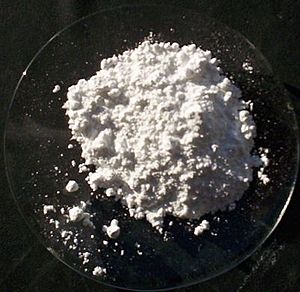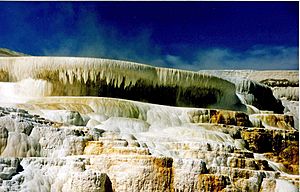Calcium carbonate facts for kids
Calcium carbonate is a very common substance found all over the world! It's a chemical compound, which means it's made when different elements join together. Its chemical formula is CaCO3. This means it contains calcium (Ca), carbon (C), and oxygen (O).
You might not know its name, but you see calcium carbonate every day! It's the main material that makes up seashells, snail shells, and even eggshells. It's also a big part of many rocks like limestone and marble.
Calcium carbonate is also what often makes water "hard". This means the water has a lot of minerals dissolved in it. Sometimes, people take calcium carbonate as a calcium supplement to help their bones. It can also be used as an antacid to help with stomach upset. But like anything, it's important not to have too much!
Contents
Where is Calcium Carbonate Found?
Calcium carbonate is found naturally in many different forms. These include various minerals and rocks that you might have seen or heard of.
Common Minerals and Rocks
Here are some of the natural forms of calcium carbonate:
- Aragonite: A mineral often found in shells and caves.
- Calcite: This is the most stable form of calcium carbonate and is very common.
- Vaterite: A less common form, sometimes found in living things.
- Chalk: A soft, white rock that was once used for writing on blackboards.
- Limestone: A sedimentary rock often used in building.
- Marble: A beautiful metamorphic rock, often used for statues and buildings.
- Travertine: A type of limestone formed around hot springs.
How to Test for Calcium Carbonate
You can easily test if a rock or mineral contains calcium carbonate.
The Acid Test
To test for calcium carbonate, you can add a strong acid, like hydrochloric acid, to the sample. If calcium carbonate is present, you will see it fizz and bubble. This fizzing is caused by carbon dioxide gas being released. Even weaker acids, like acetic acid (which is in vinegar), will make it react, but more slowly. All the rocks and minerals listed above will react with acid because they contain calcium carbonate.
Related Topics
- Aragonite: A mineral form of calcium carbonate.
- Calcite: Another common mineral form of calcium carbonate.
- Limestone: A rock made mostly of calcium carbonate.
- Ocean acidification: How oceans are becoming more acidic, which can affect creatures with calcium carbonate shells.
- Cuttlefish: Sea creatures that have an internal shell made of calcium carbonate.
- Cuttlebone: The internal shell of a cuttlefish, often given to pet birds for calcium.
Images for kids
-
Calcite is the most stable polymorph of calcium carbonate. A transparent variety called Iceland spar (shown here) was used to create polarized light in the 19th century.
-
Calcium carbonate chunks from a clamshell
-
Surface precipitation of CaCO3 as tufa in Rubaksa, Ethiopia
See also
 In Spanish: Carbonato de calcio para niños
In Spanish: Carbonato de calcio para niños








